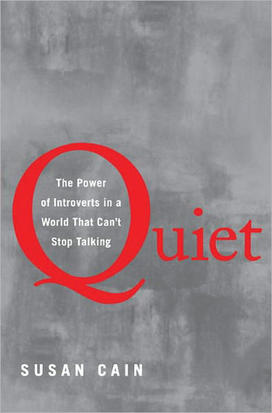Reading Room: The power of introverts
Quiet: The Power of Introverts in a World That Can’t Stop Talking, by Susan Cain ’89
In American culture today, people tend to admire the outgoing individual who would rather talk than listen, makes quick decisions, and is drawn to the spotlight. Meanwhile, we undervalue traits associated with the introvert — the quiet thinker who is deliberate, risk-averse, and likes to listen more than talk, observes Susan Cain ’89.
Introversion is “now a second-class personality trait, somewhere between a disappointment and a pathology,” she writes in Quiet: The Power of Introverts in a World That Can’t Stop Talking (Crown). An introvert herself, Cain would like to change that thinking — and help parents, educators, and employers reap the benefit of introverts’ talents.

According to studies, one-third to one-half of Americans are introverted, writes Cain. Many of their strengths, including creativity and academic success, “derive from their ability to sit still and be quiet,” she says. While introverts and extroverts on average have the same IQ level, she says, introverts tend to earn better grades in high school and college. Studies show, she adds, that a disproportionate number of very creative people in a variety of fields are introverts.
Studies also suggest that solitude and quiet fuel creativity and innovation, she says, but schools and workplaces tend to be organized in ways that can make it hard for individuals to find time and space for that. “Most introverts both in school and in the workplace are using up so much energy just to get through the day, to appear more extroverted than they really are, and to be someone other than who they really are,” says Cain, who calls the trend for so much collaborative work the “New Groupthink.”
While she sees value in teamwork, she believes some workplaces and schools have gone overboard. It’s important for children to learn to work together, and small groups managed well can be useful for quiet kids who find it easier to speak up in smaller groups than to the entire class, but group work should not dominate the school day, she says. Many schools, she says, arrange desks in groups and are assigning too many group projects. That dynamic can be overwhelming and exhausting for kids who prefer to work alone. “Many children do prefer to work autonomously, and their preferences should also be respected,” she says.
More than 70 percent of offices are set up in open plans, and the amount of personal space per employee has shrunk — which, she says, is grounded in part in the thinking that people should be interacting much of the time and work in teams, and that such interactions stimulate creativity.
A former Wall Street lawyer, Cain interviewed researchers who have observed the behavior of introverts and extroverts; measured heart rates, blood pressure, and other aspects of the nervous system; and looked at brain responses to stimuli by using an fMRI scanner in an “attempt to discover the biological origins of human temperament.” She interviewed students at Harvard’s Business School (which promotes an extroverted style of leadership), and she cites financial executives who said that more cautious, introverted leaders on Wall Street might have been more alert to warning signs before the economic meltdown.
Cain sees advancing the ideas in Quiet as “a kind of mission.” She has begun speaking to corporations and education groups to help them harness the strengths of the quiet among us. She encourages employers to arrange their offices so that individuals can disappear into private spaces when they need to work alone. And she advises educators to balance teaching methods. “Extroverts tend to like movement, stimulation, collaborative work. Introverts prefer lectures, down time, and independent projects. Mix it up fairly.”
WHAT SHE’S READING NOW: Cutting for Stone by Abraham Verghese
What she likes about it: “Being in the hands of a storyteller who is as masterful and intelligent as Verghese is.”
Tips for nurturing introverted children from “Quiet”
- “Don’t mistake your child’s caution in new situations for an inability to relate to others. He’s recoiling from novelty or overstimulation, not from human contact. ... The key is to expose your child gradually to new situations and people — taking care to respect his limits, even when they seem extreme. This produces more confident kids than either overprotection or pushing too hard.”
- “Don’t let [your child] hear you calling her ‘shy’: She’ll believe the label and experience her nervousness as a fixed trait rather than an emotion that she can control. ... Above all, do not shame her for her shyness.”
- “You can also teach your child simple social strategies to get him through uncomfortable moments. Encourage him to look confident even if he’s not feeling it. Three simple reminders go a long way: Smile, stand up straight, and make eye contact.”













No responses yet